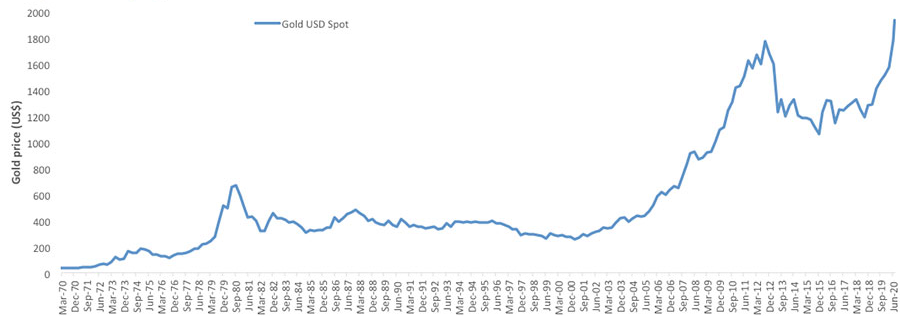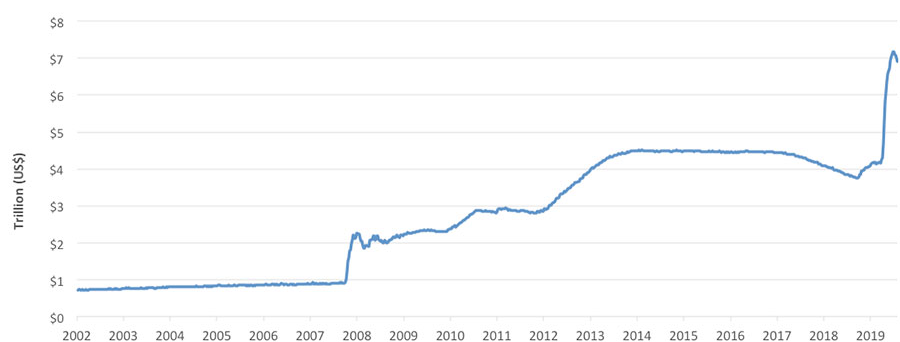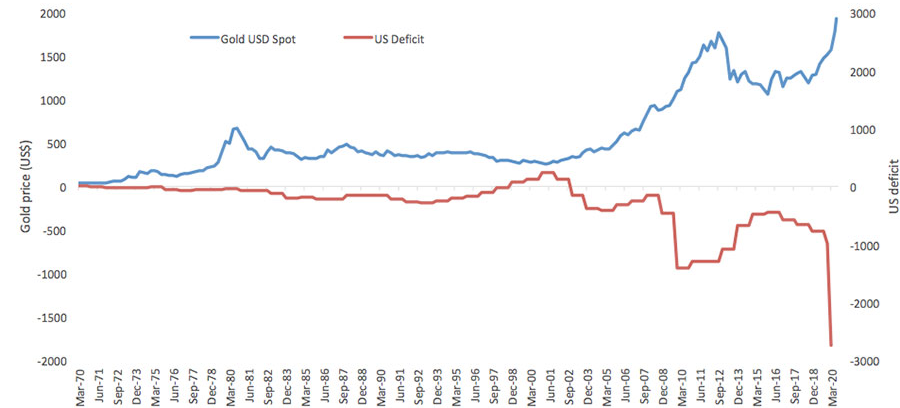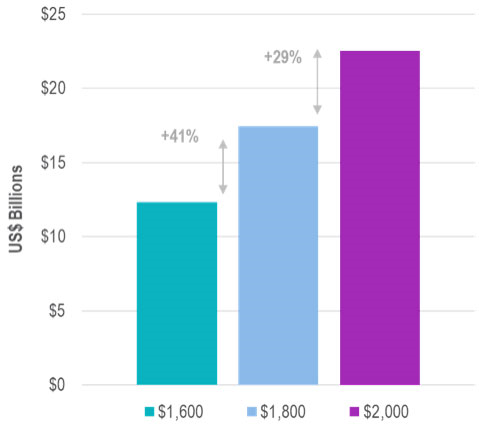Gold rush
Gold has jumped over US$1,900 in July, its highest since September 2011. Bullion’s quick move higher last month comes as the US dollar slides against all major currencies and amid negative real rates in the US given the huge size of the US Fed’s stimulus program and government spending.
“There can be no other criterion, no other standard than gold. Yes, gold which never changes, which can be shaped into ingots, bars, coins, which has no nationality, and which is eternally and universally accepted as the unalterable fiduciary value par excellence.”
- Charles de Gaulle
Riding the high
Gold has jumped over US$1,900 in July, its highest since September 2011. Bullion’s quick move higher last month comes as the US dollar slides against all major currencies and amid negative real rates in the US given the huge size of the US Fed’s stimulus program and government spending. A global resurgence in coronavirus infections and the reintroduction of lockdowns has reminded investors that a global economic recovery remains far off, forcing even more capital into the relative safety of gold and gold stocks, which provide valuable portfolio diversification.
Gold price heading higher

Source: Bloomberg, 27 July 2020
The scenario of ongoing low interest rates will help to sustain the gold price well into the future. Historically low bond yields and negative real interest rates have helped to push gold higher. When real rates are negative, investors aren’t getting any return at their cash deposits, so gold becomes competitive with interest bearing assets.
Fed balance sheet is exploding
The US Federal Reserve and other central banks in developed countries have responded to the COVID-19 crisis with alarming altruism, pumping up economies to limit the risks of prolonged recession.
Looking at the chart below, you can see the vertical rise of the blue line over the past few months in the graph below. During the 2007-08 financial crisis and subsequent recession, total Fed assets jumped to US$4.5 trillion in early 2015. Beginning in September 2019, total assets have skyrocketed to around US$7 trillion currently from just over US$4 trillion in March 2020. The expansion of Federal Reserve assets as an aggressive response to the COVID-19 crisis has been matched by an expansion of the Federal Reserve's liabilities, which must eventually be repaid.
US Federal Reserve balance sheet assets

Source: Federal Reserve of St. Louis, VanEck. Data as of 17 July 2020
As the US Government’s debt has exploded to around 40% of GDP, and real interest rates have dived below zero, analysts have been revising up their forecasts for the gold price, with some predicting it will go as high as US$2,200 to US$2,300 next year. We expect it will climb over US$2,000 with gains in the precious metal having accelerated in recent weeks. Historically, the gold price has a negative correlation to the US budget deficit, as can be seen in the chart below.
Gold price and US deficit

Source: Bloomberg
US dollar dives
Alarmed by record levels of government debt, investors have sold off the US dollar, further supporting the gold price. As the US monetary system comes under pressure, the US dollar’s status as the world’s reserve currency under the Bretton Woods Agreement is being eroded. Confidence in the US dollar too is falling given as the COVID-19 pandemic shows no sign of easing and notably poor management by US President Donald Trump. US clashes with China and an upcoming US election are also raising anxieties.
Reflecting the flight to relatively safe assets, ETFs globally have added 622 tonnes to their gold hoard this year (as at 6 July), which is already more than in any full calendar year period since gold ETFs have been in existence,2 so huge is the demand for the precious metal, according to Bloomberg data.
Appeal of gold companies
With the gold price likely to rise over US$2,000, the advantage of holding gold miners is that their price typically rises more than the gold price itself as gold miners will add their own margins to gold production. Many miners pay dividends too, adding to the potential return. This is a powerful reason to invest in gold miner ETFs, to offset rising systemic risks during the COVID-19 outbreak and beyond. And the good news for investors is that gold equities are still relatively cheap. Juniors and mid-tier miners are deeply discounted on a Price/Net Asset Value basis.
Gold companies are becoming more profitable too as the yellow metal rises in value. Since the GFC, gold companies have been implementing changes to address mistakes of the past which, in our opinion, should lead to outperformance by gold equities relative to bullion in a gold bull market. Companies’ reductions in costs and capital expenditures could translate to significant increase in free cash flow (FCF). Indeed, a US$200 move in gold price from current levels has the potential to translate to strong double-digit increases in FCF.
Cash flow leverage to gold price (seniors/mid-tiers)

Source: VanEck, Bloomberg. Data as of June 2020. “Senior” miners defined by production levels of approximately 1.5-6.0 million ounces of gold per year (“Mid-Tier” approximately 0.3-1.5 million ounces per year).
Investors can access the opportunity to invest in gold miners on ASX with VanEck Vectors Gold Miners ETF (ASX code: GDX), the world’s largest gold miners ETF.
GDX holds several Australian gold miners, including Newcrest, Evolution Mining and Northern Star, which have all made acquisitions in North America over the past year and they are starting to use their clout to expand globally. Across its whole portfolio, Canadian firms account for around half (54.4%) of GDX’s holdings, while the United States (18.2%) and Australia (14.7%) rounded off the top three at 30 June. GDX also holds the world’s largest gold miners Newmont and Barrick Gold.
Related Insights
Published: 03 August 2020
IMPORTANT NOTICE: Issued by VanEck Investments Limited ABN 22 146 596 116 AFSL 416755 (‘VanEck’) as the responsible entity and issuer of units in the VanEck Vectors ETFs traded on ASX. This is general information only about financial products and not personal financial advice. It does not take into account any person’s individual objectives, financial situation or needs. Before making an investment decision, you should read the relevant PDS and with the assistance of a financial adviser consider if it is appropriate for your circumstances. PDSs are available at www.vaneck.com.au or by calling 1300 68 38 37. All investments carry some level of risk. Investing in international markets has specific risks that are in addition to the typical risks associated with investing in the Australian market. These include currency/foreign exchange fluctuations, ASX trading time differences and changes in foreign regulatory and tax regulations. See the PDS for details.
No member of VanEck group of companies gives any guarantee or assurance as to the repayment of capital, the payment of income, the performance, or any particular rate of return of any VanEck funds. Past performance is not a reliable indicator of future performance.
Education
ETFs Explained
About Smart Beta
International Investing
Emerging Markets
Quality Investing
Moat Investing
Investing for Income
Property Investing
Investing in Infrastructure
Gold Investing
Expert Insights
ViewPoint Quarterly
ESG Investing
Investing in Healthcare
Video Gaming & Esports
Investing In Clean Energy




